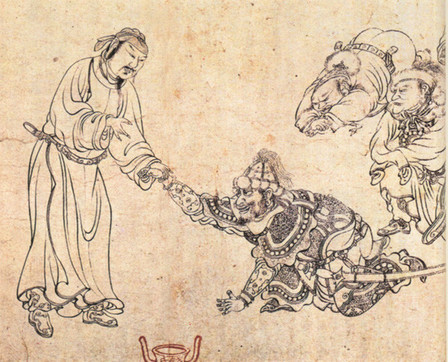Ch'an Dao Links:
|
Vimalakirti’s House
Translator’s Note: This is my English translation of the
Chinese source text entitled ‘Fa Yuan Zhu Lin ‘ (法苑珠林). This is a
Tang Dynasty Buddhist Encyclopaedia. Its
language is archaic and its sentence structure is terse. It is not easy to read and has required a ‘word
for word’ as well as a ‘thought for thought’ translation. The two translations have been skilfully
merged to form a single coherent narrative in modern English. The birth and death dates for Wang Xuan Ce (王玄策) are unknown. He was born in Luoyang, Henan province,
China. The place of his death is
unknown. He served as Chinese Ambassador
to India (天竺 – Tian Zhu – also known as ‘North India’ 北印度 – Bei Yin
Du) on four different occasions – under the Tang Dynasty Emperors Taizong (太宗.) and Gaozong (高宗).
During these Ambassadorships – Wang Xuan Ce encouraged a rich cultural
exchange between India and China. In the
second year (657) of the Xian Ping imperial era (656-661) – Wang Xuan Ce was
sent back to India for the third time.
It was probably around 660-661 that he visited Vaisali – the birthplace
of the enlightened layperson known as ‘Vimalakirti’. According to Wang, he was shown the house (or
what was left of the foundations) that once belonged to Vimalakirti. Wang measured the structure as being longer
than 50 Chinese feet. What is
interesting is that despite over a thousand years (or more) since the lifetime
of Vimalakirti – people in the Vaisali area still knew of him and could point-out
places relevant to his biography and explain something about his personal
habits.
ACW 12.3.15 Extracted From: Dharma Park Pearl Forest (法苑珠林 – Fa Yuan Zhu Lin) – Buddhist Encyclopaedia No. 2122 法苑珠林 (卷39) T53, p0597a Author: Wang Xuan Ce (王玄策) Chinese Ambassador in India Sent from the Great Tang (大唐 – Da Tang) Dynasty (7th Century CE) Date: Xian Ping (顯慶) imperial era (656–661) Location: Zhong Nan Zhe Gu (終南折谷) – (i.e. Vaisali, Northeast India) At Meridian Mountain Pass (south section), there is a relay station named Three Intersections. To the south of the station there is a stream. The southeast slope measures 10 hectors. There are chestnut trees. Initially it is not clear if holy people live here. Bells are repeatedly heard – but it is not thought odd. At a temporary (rest) station, lay-women collect firewood and enter the stream. Suddenly a single holy being appears. He sits alone on a stone, sewing clothing. Nothing bothers this solitary being. A woman approaches with confidence. She enquires whether this holy being requires feeding on this day. This sage lives in seclusion on the mountain and does not need feeding. He receives food from a lay-official at the relay station. The woman questions whether he receives enough? The monk answered that those with conviction always have enough to eat. Hearing this the woman was afraid and ran away. There was no trace of the food. True food is not valued by the unenlightened. The bell sounds. Vimalakirti’s house is five miles from this relay station. The ‘Zhong Nan’ (i.e. ‘Vaisali’) area is where Vimalakirti lived. We see a monk and question him about Vimalakirti. There are many houses – which one was his? The reply is that he lived at the East Ridge of the valley. Many people want to know where this blessed sage lived. A monk approaches from the South Cliff and using refined speech he asks us to follow him. Vimalakirti’s house is measured as being 50 feet long (可長五十尺 – Ke Chang Wu Shi Chi).* The monk said that Vimalakirti used to go daily into the hills to collect firewood. When gathering firewood, he would eat vegetarian biscuits. He did not have to scavenge for food along the side of the road. If not biscuits, then bread. His wife lived simply – he then said. She did not speak for many years. We then saw two other monks in the valley. There were many holy beings in this place. We now talked with 3 holy beings. They said when people are close to death – they are taken into the mountains (where Vimalakirti gathered firewood), and often hear a bell ringing. Then an unknown holy person appears. This holy person is never too far away. We have already heard this bell in the valley. This is believed to be Vimalakirti’s doing. Is this the work of Vimalakirti we ask? With great virtue and Dharma practice – all can be accomplished – we are answered. The generation of virtue and Dharma practice go hand in hand. When the wind blows, sounds are carried to the ears of those who want to hear them. This is what the mind and heart say. This is why Vimalakirti is a sage. If we enter the mountains, we may stumble upon Vimalakirti and have to bow our heads to the floor out of respect. Those who do not study self-cultivation will not know if they meet him. Their minds will be clouded by anger. After 3 days we returned to the mouth of the valley. A Vihara is entered to leave the world. All is understood in the lecture hall, but many monks remain unaware of the end goal. *A ‘Chi’ (尺) is about one-third of a meter. However, during the Tang Period there were two ‘Chi’ measurements in use: Tang Dynasty Generation - Large scale Chi: about 29.4 cm (唐代的大尺:約29.4公分) Tang Dynasty Generation - Small scale Chi: about 24.6 cm (唐代的小尺:約24.6公分) ©opyright: Adrian Chan-Wyles (ShiDaDao) 2015. |
